Jul 2004, Vol. 8 No. 9
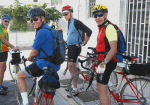 Narrow roads weaving through century-old, twisted olive groves (producing some of Italy’s finest olive oil)have become paths for bicycle riders pedaling in Puglia (Apulia). Many of these vineyards and vegetable fields house unique white slate beehive-shaped trulli. Along the blue waters of the Adriatic, small boats unload copious amounts of fresh, tender octopus and squid.
Narrow roads weaving through century-old, twisted olive groves (producing some of Italy’s finest olive oil)have become paths for bicycle riders pedaling in Puglia (Apulia). Many of these vineyards and vegetable fields house unique white slate beehive-shaped trulli. Along the blue waters of the Adriatic, small boats unload copious amounts of fresh, tender octopus and squid.
During our 9-day Ciclismo Classico cycling trip along southern Italy’s ‘spur’ and ‘heel’, bordered by the Adriatic Sea to the east and the Ionian or Gulf of Taranto on the south, we saw no tourists other than a few other riders. Perhaps, equally appealing is the lack of tourists visiting Puglia. 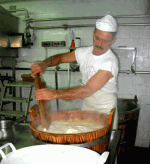
Bari, the capitol of Puglia, had its day of glory as a Byzantine strongh Today, the port city serves as the gateway for catching the ferry to Greece. Here, we met twenty-five Americans and Canadians for our shuttle ride 19 miles to the small village of Polignano a Mare, the start of our bicycle tour through Puglia.
The 16,000 inhabitants of Polignano a Mare live atop the plateaus of sheer cliffs overlooking the turquoise waters of the Adriatic. The open windowsill of our Hotel Grotta Palazzese room was a straight shot to the water. From a nearby room, an avid angler dropped a fishing line a hundred feet or so into the ocean. Offshore, evening fisherman in small boats attracted fish and calamari (squid) into their nets using lights. 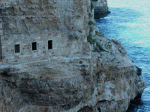
After fitting our bikes and listening to a safety briefing, “point your hand in the direction you’re turning, hold your line straight, and angle your arm down if you’re slowing”, we took a warm-up ride through narrow cobblestone streets. You could almost reach your arms between the homes lining the streets. Stopping along scenic shoreline spit, our guide Sheri pulled out a map to give us a preview of trip highlights.
As if doomed to a dungeon we descended a narrow stone circular staircase. Ten stories below, a walkway above the sea led to a stunning grotto, the hotel’s dining area. Under the concrete floor, birds flew to nestle overnight just above the waves crashing against the rocks. 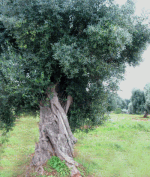
Bicycling between Polignano a Mara and Alberobello, a distance of 30-some miles we rode through a cornucopia of vegetable fields. Each plot appeared to be anchored by century-old olive, nut (almond) and fig, plum, apricot, pear, orange fruit trees. The few vegetables we could identify included arugula, broccoli, fennel, cabbage, parsley, onions, garlic, and corn.
The area surrounding the city of Alberobello, a UNESCO World Heritage site, has the greatest concentration of truillis in Southern Italy. The steep grade of the single lane road had a distant view of the Adriatic. Beehive-shaped truilli’s were scattered among the fertile landscape. The whitewashed conical, pinnacle roofed houses, built without the use of mortar, are concentrically tiled in grey slate. Pinnacles and sides are frequently painted with astrological or religious symbols. 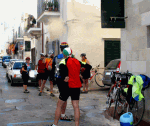
We stopped to enjoy a homemade lunch at Azienda Agrituristica Biologica Serragambetta. Domenico and Perna Lanera’s 90-year old mother gave us a pasta cooking demonstration. The family-owned eighteenth century villa serves pre-arranged lunches and has seven small rooms for overnight guests. In the 16th century Pope St. Gregorio Magno built the Abbey of St. Maria in Barsento. Today, the ancient restored farmstead known as “I Monti” is a four-star resort.” Its two-bedroom suites and foyer are built trulli-style in whitewashed limestone.
After a challenging day of riding, it felt great to relax in this unique accommodation. I Monte offers dining service only for its guests. Locorotondo, a circular village perched on a hill, was our destination for a day loop ride. Cycling again through fields of grapes, olives and fruit trees with rows of planted vegetables, we stopped for lunch in Martina Franca, a village founded in the 10th century by refugees fleeing the Arab invasion of Taranto. 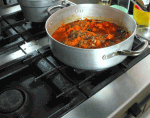
Buildings of baroque architecture surrounded its cobblestone plaza. We wandered into a cafe for homemade pasta mixed with delicacies from the sea–mussels, squid, and octopus. Families wandered in after Sunday mass, while others headed home, leaving the streets empty. The city of Alberobello is divided by two hills that were once separated by a ancient riverbed. The old trulli village is located on a steep hillside surrounded by almond and olive groves.
The residents of Alberobello have lived on this porous land since the late 11th century. The dwellings, built with sheets of slate known as chiancole, spared residents from property taxes. Without mortar, they were freed from imposed taxed because their trulli were allegedly movable. Ferdinando IV of Bourbon absolved the payment of this tax.
Tucked by the roadside, a deli case in the Cubana Cafe brimmed with fresh anchovies, octopus, mozzarella, proscuitto, eggplant, olives, rolls, salami, and Parma ham. Buying a variety of goodies in many small plastic containers, it suddenly occurred to me that I might have ” bought the store.” When the storekeeper added up the tab, the grand total amount to $6 Euro. 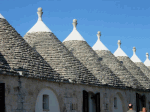
Riding through the small fishing port of Savelletri, we passed the city of Fasano enroute to our destination of San Domenico. We enjoyed our deli antipasto picnicking on a rocky outcropping overlooking the crystal clear blue Adriatic.
Masseria San Domenico is one of Puglia’s luxury destination resort attracting primarily golfers, spa-goers and would you believe bicycle riders? Located in the middle of an olive grove, the whitewashed 5-star accommodation is a member of one of the Leading Small Hotels of the World. For the first time we encounter tourists, three bicycle groups: Backroads Active Adventures, upscale Toronto-based adventure company Butterfield and Robinson, and a private custom group.
One night we dined elegantly at San Domenico, another night we enjoyed a hearty four-course dinner along the shore of the Adriatic. Dinner was followed with a program by young costumed folkloric dancers from Alberobello. 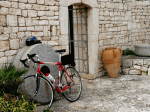
The whitewashed city of Ostuni has the appearance of a North African city. A 15th century Gothic cathedral towers over the central plaza. The village is a tangle of narrow cobblestone streets with arched stairways.
Riding six days in glorious weather–70-degree days (50 at night), the skies poured torrential rain. Fortunately it was a day of shuttle travel. Some of our group on the “mini-tour” headed home, while the rest of us loaded into several vans for a five-hour shuttle to Gargano– the ‘spur’ of Italy’s boot.
The hilly promontory coastline beckons with crashing waves on beautiful beaches. The riding graduated from rolling hills to steeper mountains. Instead of winding through ancient cities and olive groves, we followed the two-lane highway from Vieste to Peschici, a hillside town surrounding a picturesque bay. The white buildings of the city give a Greek or Mediterranean appearance. 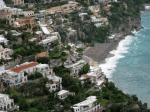
A white limestone rock monolith, Promontorio del Gargano, or Pizzomunno looms as the gateway to the city of Vieste. The mammoth rock appears as if it suddenly calved from the abrupt cliffs of Vieste. The old town with whitewashed houses and winding medieval streets was the grisly site of thousands of locals who were beheaded by the Turks in the 16th century.
Frederick II built a castle at the town’s highest point, a closed to visitor’s site used by the military. Most visitors come to Vieste for the beaches rather than its history. Much of the area is located in Gargano National Park, a pine forest mixed with maple, beech and lime trees. The plan for our second day in Vieste was a boat ride to view scenic grottoes dominating the coastline. Unfortunately, the storm of the previous day churned the seas canceling our trip.
Once again, we mounted up and cycled the coast viewing scenic cliffs and a World War II military tower. All too soon our eight days in the bike saddle were over. We celebrated our final evening at Enoteca Vesta feasting on tender octopus and squid marinated in Puglia’s extra virgin olive oil.
After an early morning shuttle to Foggia, we said our good-byes and exchanged emails before going our separate ways, some to explore more of Italy or head back to the States.
If you go: Ciclismo Classico: www.ciclismoclassico.com Hotel Grotta Palazlese: www.grottapalazlese.it or email [email protected] Barsentum “I Monte” [email protected] or www.barsentum.it Masseria San Domenico [email protected]
or www.masseriasandomenico.com Hotel degli Aranci www.hotelaranci.com or [email protected] Rome is the gateway to Italy. On our way to Puglia, we stayed Hotel Modigliani (www.hotelmodigliani.com or [email protected]) in Rome. Leaving Italy we stayed at Rome’s Hilton Calaveri (www.cavaleri.hilton.it or www.hilton.com).
The Cavaleri overlooks the dome of St. Peter’s with a panoramic view of the Eternal City. Its 2-star Michelin La Pergola features the cuisine of Chef Heinz Beck and is known as “a restaurant in a hotel not a hotel restaurant.” A more economical dining alternative is Il Giardino dell’Uliveto which serves delightful food in a decor featuring unique bonsai olive trees.
Route Rap: Ciclismo’s Best of Southern Italy
Day 1 6.6 mile Polignano Loop ride stayed at Grotta Palazzese
Day 2 29.8 miles from Polignano to Balsente with lunch at Agriturismo Grotte to Masseria Fortificata I Monti, 2 nights spent in trulli-like accommodations.
Day 3 32.8 Locorotondo Loop Ride from I Monte, lunch on own in cellar in Martina Franca
Day 4 30 miles to Savelletri, Fasano to San Domenico with picnic lunch on Adriatic. Masseria San Domenico 5-star resort in Savelletri di Fasano for two nights.
Day 5 38 miles to Ostuni with picnic lunch and walking tour. End of mini-tour.
Day 6 5-hour shuttle to Vieste “the spur of the boot” with a visit at the 900-year-old cathedral of Trani, the only Italian cathedral built by the sea.
Day 7-9 Hotel Degli Aranci in Vieste in Gargano region. Three nights at hotel then transfer to Foggia where we caught train to Naples to the Amalfi Coast.
